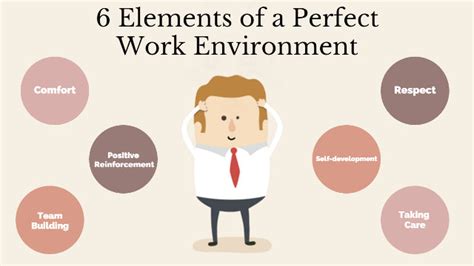Preferred Work Environment: Communicating Your Choice

Choosing the right work environment is essential for your productivity, job satisfaction, and career success. Whether you prefer a quiet office, a collaborative team, or a flexible schedule, it’s important to communicate your preferences to your employer or potential employer. In this article, we’ll explore the different aspects of a preferred work environment and how to effectively communicate your choice.
Why Your Preferred Work Environment Matters
Your preferred work environment can significantly impact your job performance, happiness, and well-being. When you work in an environment that aligns with your preferences, you’re more likely to:
- Feel motivated and engaged
- Be productive and efficient
- Collaborate effectively with your team
- Feel valued and respected
- Maintain a healthy work-life balance
Factors That Affect Your Preferred Work Environment
Your preferred work environment can be influenced by various factors, such as:
- Your personality type and work style
- Your job responsibilities and tasks
- Your communication and collaboration preferences
- Your physical and mental well-being
- Your personal and professional goals
How to Communicate Your Preferred Work Environment
Communicating your preferred work environment can be challenging, especially if you’re not sure how to express it or if you’re afraid of being perceived as demanding or difficult. However, there are several strategies that can help you effectively communicate your preferences:
1. Assess Your Needs and Wants
Before you communicate your preferred work environment to your employer or potential employer, you need to have a clear understanding of what you need and want. Make a list of your ideal work environment based on the factors that matter to you the most. Ask yourself questions like:
- Do I prefer a quiet or a noisy workplace?
- Do I work better alone or in a team?
- Do I need flexibility in my schedule?
- Do I prefer a structured or a flexible work environment?
- Do I need access to certain tools or resources?
Once you have a clear idea of your preferences, you can communicate them effectively to your employer or potential employer.
2. Research the Company’s Culture and Values
Before you apply for a job or accept an offer, research the company’s culture and values to see if they align with your preferences. Look for information on the company’s website, social media, and review sites. Check if they offer any perks or benefits that match your needs and wants. If possible, talk to current or former employees to get a better understanding of the work environment.
3. Be Honest and Direct
When communicating your preferred work environment, be honest and direct. Don’t beat around the bush or sugarcoat your preferences. Instead, state them clearly and confidently. Use “I” statements to express your needs and wants, such as:
- “I work best in a quiet environment where I can focus on my tasks.”
- “I prefer a collaborative work environment where I can bounce ideas off my team.”
- “I need flexibility in my schedule to accommodate my personal responsibilities.”
By using “I” statements, you avoid sounding demanding or judgmental.
4. Be Open to Compromise
While it’s important to communicate your preferred work environment, it’s also important to be open to compromise. Your employer or potential employer may not be able to provide everything on your list, so be willing to negotiate and find a middle ground. For example, if you prefer a quiet workplace but your team needs to collaborate frequently, you can suggest using headphones or finding a separate space for meetings.
5. Follow Up and Check-In
Once you’ve communicated your preferred work environment, follow up and check-in regularly to see if your needs and wants are being met. If not, express your concerns and suggest solutions. Keep an open and honest dialogue with your employer or potential employer to ensure a positive and productive work environment.
FAQs
Q: What if my preferred work environment is not available?
A: If your preferred work environment is not available, be open to compromise and find alternative solutions. For example, if you prefer a quiet workplace but your employer cannot provide it, try using noise-cancelling headphones or finding a quiet corner in the office.
Q: How do I communicate my preference for a flexible schedule?
A: When communicating your preference for a flexible schedule, be clear about your availability and constraints. Explain why a flexible schedule is important for you and how it can benefit your employer. Offer solutions and suggestions, such as working from home or adjusting your work hours.
Q: What if my employer does not respect my preferred work environment?
A: If your employer does not respect your preferred work environment, speak up and express your concerns. Provide evidence and examples to support your preferences. If the situation does not improve, consider finding a different job or seeking legal advice.
Conclusion
Communicating your preferred work environment is crucial for your job satisfaction and success. By assessing your needs and wants, researching the company’s culture and values, being honest and direct, being open to compromise, and following up regularly, you can effectively communicate your preferences to your employer or potential employer. Remember to keep an open and honest dialogue and be willing to find alternative solutions if necessary.
